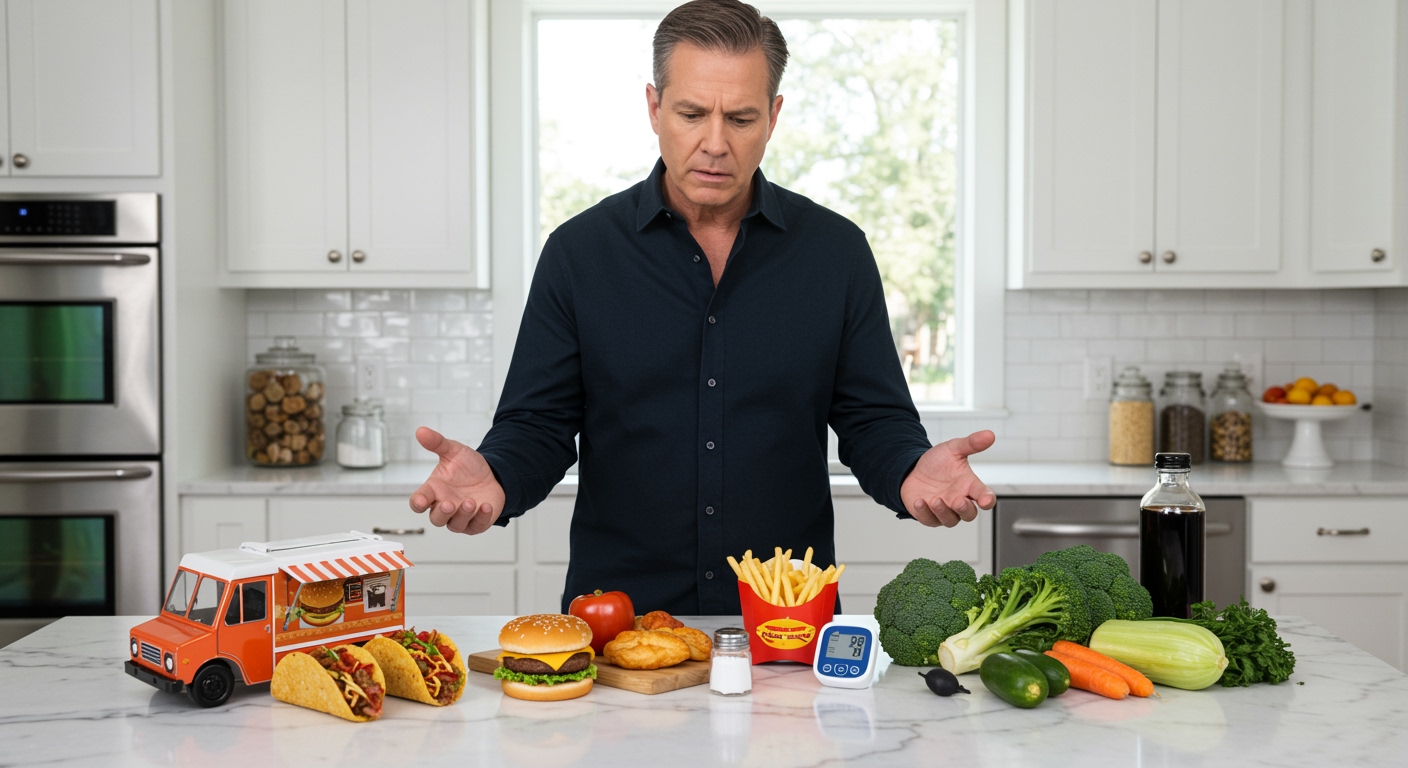✪ Key Takeaway: Hypertensive patients can eat from food trucks by choosing grilled options, avoiding fried foods, and asking for no added salt.
Introduction
The smell of sizzling burgers and crispy fries draws you toward that colorful food truck parked on the corner.
But then you remember your doctor’s warning about high blood pressure and wonder if these mobile kitchens are off-limits forever.
Hi, I’m Abdur, your nutrition coach and today I’m going to explain exactly how hypertensive patients can navigate food truck dining safely without completely avoiding this popular food scene.
What Makes Food Truck Meals Risky For Blood Pressure?
Food trucks face unique challenges that often lead to high sodium content in their meals.
Most food truck operators rely heavily on processed ingredients and pre-made sauces to speed up service and reduce costs.
These shortcuts create meals that can contain 2000-4000 mg of sodium per serving, which exceeds the entire daily recommended limit for hypertensive patients.
The cooking methods commonly used in food trucks also contribute to the problem.
Deep frying, heavy seasoning, and generous use of condiments all add extra sodium and unhealthy fats to meals.
Limited storage space forces many food truck owners to use preserved meats and canned ingredients that are loaded with sodium as natural preservatives.
✪ Fact: A single food truck burger can contain more sodium than three days worth of recommended intake for hypertensive patients.
Which Food Truck Options Are Actually Safe?
Grilled proteins without heavy marinades or sauces represent the safest choice for people with high blood pressure.
Look for food trucks that offer plain grilled chicken, fish, or lean beef that you can season yourself with fresh herbs or lemon juice.
Fresh vegetable options like salads, grilled vegetables, or veggie wraps provide excellent alternatives when prepared without excessive dressings.
Many modern food trucks now offer customizable bowls where you can control exactly what goes into your meal.
Choose brown rice or quinoa as your base, add grilled proteins, and load up on fresh vegetables while skipping high-sodium sauces and dressings.
Ethnic food trucks that focus on Mediterranean, Vietnamese, or Mexican cuisine often provide healthier options than traditional American fast food trucks.
These cuisines naturally emphasize fresh ingredients, herbs, and spices rather than relying heavily on salt for flavor.
✪ Pro Tip: Always ask food truck operators to prepare your meal without added salt and request sauces on the side.
How Can You Make Smart Choices At Food Trucks?
Start by reading the menu carefully and asking questions about preparation methods before ordering.
Words like fried, breaded, crispy, or smothered usually indicate high-sodium, high-fat preparations that spike blood pressure.
Instead, look for terms like grilled, steamed, roasted, or fresh which typically indicate healthier cooking methods.
Most food truck operators are willing to customize orders if you explain your dietary needs politely and clearly.
Ask them to skip the salt during cooking, serve sauces and dressings on the side, and substitute fried sides with fresh options when available.
Portion control becomes crucial when eating food truck meals since serving sizes are often much larger than recommended.
Consider sharing a meal with someone else or immediately saving half for later to avoid consuming excessive sodium and calories in one sitting.
✪ Note: Drinking extra water after food truck meals helps your kidneys process excess sodium more effectively.
What About Food Safety Concerns?
Food trucks must follow the same health department regulations as traditional restaurants in most areas.
However, the mobile nature of these businesses can create additional challenges for maintaining consistent food safety standards.
Look for food trucks that display their health permits prominently and maintain clean, organized service areas.
Pay attention to how food is stored and whether proper temperatures are maintained for hot and cold items.
Trust your instincts if something looks, smells, or tastes off, and do not hesitate to walk away from any food truck that appears unsanitary.
For hypertensive patients, foodborne illness can be particularly dangerous because it may interfere with blood pressure medications and cause dehydration.
Choose food trucks with high turnover rates where food is prepared fresh and served quickly rather than sitting under heat lamps for extended periods.
✪ Fact: Food trucks with long lines often indicate fresher food because high turnover prevents ingredients from sitting too long.
The Bottom Line
Hypertensive patients do not need to completely avoid food trucks, but they must approach them with knowledge and caution.
Smart choices and clear communication with food truck operators can make street food part of a heart-healthy lifestyle.
I would love to hear about your experiences with food truck dining or any questions you might have about managing high blood pressure while enjoying diverse food options – please share your thoughts in the comments below.
References
At NutritionCrown, we use quality and credible sources to ensure our content is accurate and trustworthy. Below are the sources referenced in creating this article:
- Healthline: Low Sodium Fast Food Options
- CSPI: How Salty is Too Salty
- UAB: Food Truck Safety
- Trust20: Food Truck Food Safety





